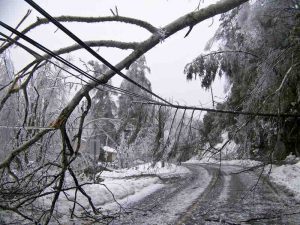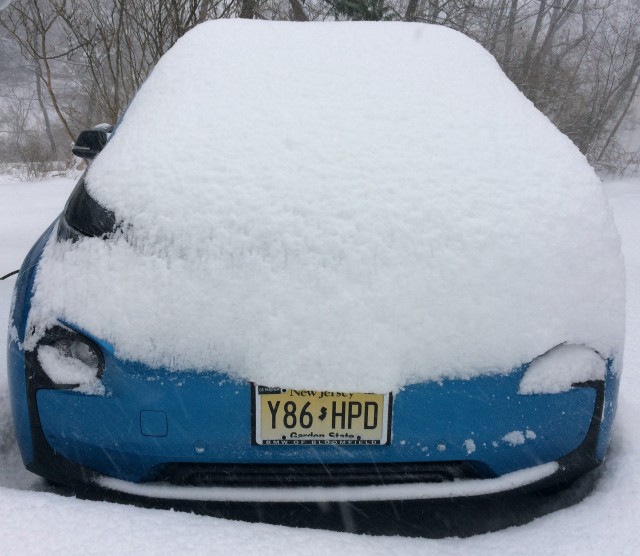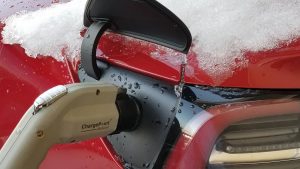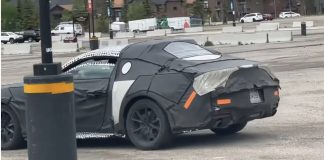Winter – and cold weather – is just a few months away and that means more than just cold and probably snow.
It also means power outages.
Sometimes, these last for several days. Last year, for example, an ice storm in my area took down many trees and with them several power lines. The juice was off for almost a week.
How does one recharge an electric car in this scenario?
The answer, of course, is that one doesn’t. Not unless one has a whole-house back-up generator that produces the 200 amp service necessary to power the “fast” charger. Most people don’t have that kind of back-up power, because it’s expensive. The typical install is about $5,000 for the generator and supply/hook-up to natural gas, propane or diesel (which will produce “emissions” while charging up the “zero emissions” EV).
Fold this cost into the cost of your EV.
A smaller, more affordable portable generator – the kind most people who have to deal with power outages usually do have – costs less (about $600 for a 5,000 watt unit that will run a few 120v circuits and so keep the lights on and the fridge working) but doesn’t produce enough power to run an EV “fast” charger. If you need a charge, it’ll be slow.
This could be inconvenient if you need to get someplace now. Or even soon.
Maybe tomorrow?
Just another example of the pending problems people will be experiencing once EVs are shucked-and-jived (and subsidized) into their garages.
Contrast this scenario of hassle and expense with the minor inconvenience of a power outage when your car is liquid-powered. Unless the tank is empty, you can go right now – no waiting, no hooking up to a gennie. And if it’s empty, all you need is a jug. Most gas stations have their own back-up power and the pumps will be on. Go get a gallon and you’re good to go.
It’s not just ice storms, either. There is a hurricane – the androgynous Dorian – bearing down on the east coast of the U.S. If it is strong enough and bad enough when it hits, the power will likely go off in many places. People will be wanting to flee those places, too – because in addition to the power going off, the water may be coming in. That means lots of people on the road all at once. Running out of power before you can get out of dodge is another problem EV People will be dealing with.
Which brings up a seemingly reasonable question:
Why bother?
Why accept all these hassles and expenses?
Isn’t it astonishing how eager people are to exchange something that works better (and for cheaper) for something that doesn’t and isn’t?
And they ask my why I drink . . .
. . .
Got a question about cars, Libertarian politics – or anything else? Click on the “ask Eric” link and send ’em in!
If you like what you’ve found here please consider supporting EPautos.
We depend on you to keep the wheels turning!
Our donate button is here.
If you prefer not to use PayPal, our mailing address is:
EPautos
721 Hummingbird Lane SE
Copper Hill, VA 24079
PS: Get an EPautos magnet (pictured below) in return for a $20 or more one-time donation or a $10 or more monthly recurring donation. (Please be sure to tell us you want a sticker – and also, provide an address, so we know where to mail the thing!)
My latest eBook is also available for your favorite price – free! Click here. 













Wow I didn’t realize whole house generators were only a few grand. That’s cheaper than a used car! And the only thing that could take out the natural gas system is an earthquake since the natural gas “grid” runs on natural gas.
Just for shits and gigs I’ll refute the “fast charge” point again. Fast charging doesn’t matter for most people because they charge the car at night while they sleep.
Grid electricity is actually super cheap at night. Sometimes the rates even go negative! You see, power companies don’t hate grid demand, they hate uneven grid demand. EVs smooth out that demand, allowing the power station to run at a more consistent and predictable load.
This doesn’t even take into consideration the fact that EVs in every garage make up a mini decentralized power grid. Decentralized grids are much harder to take down because there is no central point. I’d like to see an ICE car power an entire house for a few days.
WFjacoby – wow all that made absolutely no sense. So a Tesla is going to power the house. Huh? Or you can get a generator that will absolutely do it for almost nothing. Ive never seen variable electricty pricing. What are you talking about? If it goes negative they pay you?
Yes, large batteries parked in the garage mean that powering the house off of the family car during an outage is a future possibility.
And yes, variable electricity pricing is a thing. It’s called time of use billing.
WTF….uh WF, It’s obvious you know nothing about natgas. The gas is forced down the line with this thing called a pump. Dangest think you ever saw. It runs on electricity. Not only that, it has all sort of devices for safety and to ensure it runs the same pressure and they all work off electricity. They’re pretty complex systems but please, don’t let facts get in your way. Educate us more about something else you know completely nothing about.
Directly from the American Gas Association: “Most compressors in the natural gas delivery system use a small amount of natural gas from their own lines as fuel.”
Is there anything else you’d like to be proven wrong about today Boomer? Perhaps I could help you google something or open a .pdf?
“Most compressors in the natural gas delivery system use a small amount of natural gas from their own lines as fuel.”
Is that a natural gas powered pump? Or electric from a natural gas generator?
But unless we drive electric cars, winter will be a thing of the past, ‘cause all that CO2 will keep building up and heat up the planet, right?
if its too cold like here in MN winter it wont even charge with a 120v charger plugged in. I’ve read where it literally couldn’t charge without going to a tesla charger in the cold -30 winter.
I’ve worked on and watched new transmission systems go in for years to service, mainly, the wind generated power. It’s a big deal and so is replacing lines for ever-growing electrical needs. I watched the same line get replaced by a larger line twice in 3 years.
Trying to figure out where to get power and how and where to take it is expensive and complicated. We could all have Tesla’s tomorrow and sit at the house every day simply because no town, hamlet, large towns, small cities and especially, large cities are always on the ragged edge for power.
It ain’t cheap and it ain’t fast. I think the average person has no idea of the cost and time-line for supplying power….assuming there is power to supply.
Eric,
While it may be difficult, if not impossible to charge an EV during a mass evacuation, the same is true for an ICEV too. You’re assuming: 1) that fuel will be available at all; and 2) the pumps will have power. Even if the station has its own backup power source, they may not have fuel. If every Tom, Dick, and Harry escaping town gasses up, the tanks could very well be dry by the time YOU get to them. Ergo, it’s best to keep the tank full.
…which is a lot easier to do in an ICEV.
Hi Mark,
This is true – but if I have a full tank, even my Trans-Am can get 200-plus miles down the road and so escape the hurricane’s worst. If you didn’t charge up your EV before you need to flee, you are well and truly screwed. Once again, we circle back to the fulsome scurvy truth that EVs are less practical and more hassle than IC cars.
That’s assuming you HAVE a full tank! Many people don’t keep their tank full; my brother is one of them. Even if your tank is full though, you’ll need fuel along the way, right? People won’t just be evacuating your area; they’ll be evacuating other areas too. When everyone floods the highways, fuel economy won’t be CLOSE to optimum; even that full tank will go down quickly. If you need to refuel along the evac route, you might not be able to do so because EVERYONE will want to do so, and there won’t be enough fuel to go around.
Hi Mark,
Sure. But I can (and do) keep about 20 gallons of gas on hand at all times in jugs. So even if my tank is empty and the power is out, I can fill my tank in minutes – and be ready for a 300 mile nonstop trip. If the EV isn’t charged fully and the power goes out, you’re not going anywhere, city boy (as the Toothless Man said in Deliverance).
Also, I have motorcycles. Very little gas needed to go 150-plus miles at a moment’s notice.
My point – again – is that from whatever angle you view it, the EV can’t match the practicality/versatility and ease of use of an IC car.
Jerry Cans full of fuel. Even my smallest vehicle can carry at least four. That is at lest 700 miles of ‘recharge’ in the trunk, even if the tank is empty. 1100+miles with a full tank plus Jerry Cans.
Note how every time this is brought up, the EV crowd is completely blind to this. It absolutely destroys their arguments so it is ignored.
And Eric, this will definitely make your teeth ache.
https://oilprice.com/Energy/Energy-General/Busting-The-Myth-Of-The-Worlds-Hottest-Electric-Car-Market.html
Normal, sane person: “If it ain’t broke, don’t fix it.”
The government: “If it ain’t broke, we’ll break it and then ‘fix it’!”
My old 6.5 Turbo Diesel could get 600 miles on a single tank and that’s not counting the 80 gallon nurse tank which works out to 1800 miles without a fillup.
Batteries don’t like cold. At freezing batteries are 30 – 50% less efficient. Then you have the heater warming up the battery and another heater warming up you. Don’t forget the rear electric defrost and some have them up front as well. Windshield wipers on to keep the ice and snow at bay. All lights are on because “it’s the LAW” in many places when it’s raining or snowing. Wheel drive motors may lock up due to ice and cold. Seen motors seize up when working at industrial plants years ago,,, back when we had manufacturing. Electrics don’t like salt they use up north in winter. Stuff gets everywhere and will eat the insulation off the wires. Then a accident occurs and you’re held up a couple of hours using your heater. Then when traffic starts moving you don’t because your battery is kaput. Then ‘Authorities’ will tell you to ease up on usage because the grid is overwhelmed.
Yep,,, nothing like good ole progress!
Modern progress means breaking shit that ain’t broken, and then “fixing them”.
Well, look at the bright side: those idiots won’t be out trying to drive their electric cars with 3″ ground clearance in the blizzard.
dread, I don’t know where to push really. Should that Ranch Hand line up with the back-up cams or where? I’d bet Tesla’s are a bitch to load on a truck, esp. the ones still burning.